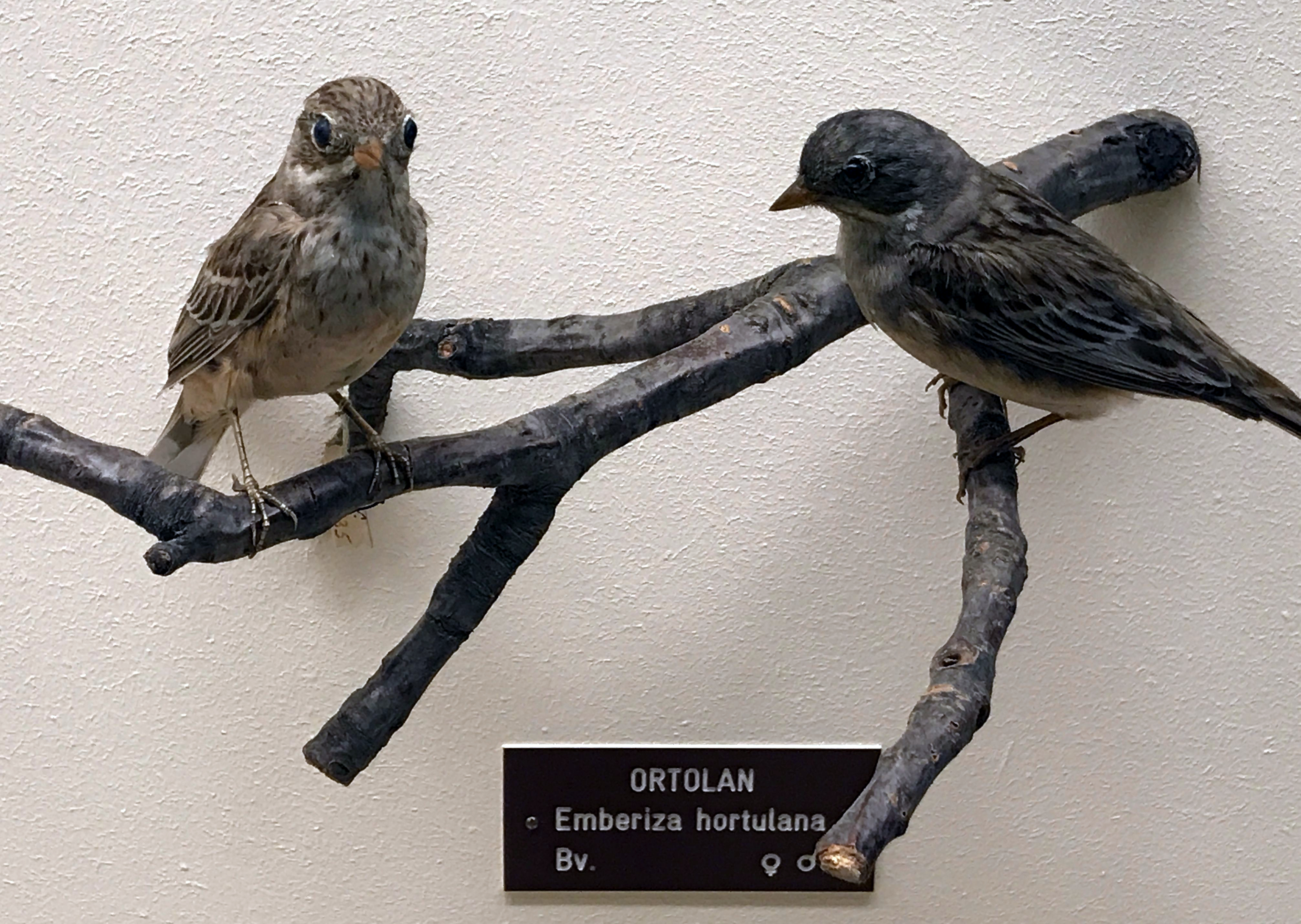|
Ortolan Bunting
The ortolan (''Emberiza hortulana''), also called ortolan bunting, is a Eurasian bird in the bunting family Emberizidae, a passerine family now separated by most modern scholars from the finches, Fringillidae. The genus name ''Emberiza'' is from Alemannic German , a bunting. The specific ''hortulana'' is from the Italian name for this bird, . The English ''ortolan'' is derived from Middle French , "gardener". The ortolan is served in French cuisine, typically cooked and eaten whole. Traditionally diners cover their heads with their napkin, or a towel, while eating the delicacy. The bird is so widely used that its French populations dropped dangerously low, leading to laws restricting its use in 1999. In September 2007, the French government announced its intent to enforce long-ignored laws protecting the bird. Taxonomy The ortolan bunting was described by the Swedish naturalist Carl Linnaeus in 1758 in the tenth edition of his ''Systema Naturae'' and retains its original bin ... [...More Info...] [...Related Items...] OR: [Wikipedia] [Google] [Baidu] |
Carl Linnaeus
Carl Linnaeus (; 23 May 1707 – 10 January 1778), also known after his ennoblement in 1761 as Carl von Linné Blunt (2004), p. 171. (), was a Swedish botanist, zoologist, taxonomist, and physician who formalised binomial nomenclature, the modern system of naming organisms. He is known as the "father of modern taxonomy". Many of his writings were in Latin; his name is rendered in Latin as and, after his 1761 ennoblement, as . Linnaeus was born in Råshult, the countryside of Småland, in southern Sweden. He received most of his higher education at Uppsala University and began giving lectures in botany there in 1730. He lived abroad between 1735 and 1738, where he studied and also published the first edition of his ' in the Netherlands. He then returned to Sweden where he became professor of medicine and botany at Uppsala. In the 1740s, he was sent on several journeys through Sweden to find and classify plants and animals. In the 1750s and 1760s, he continued to collect an ... [...More Info...] [...Related Items...] OR: [Wikipedia] [Google] [Baidu] |
Monotypic
In biology, a monotypic taxon is a taxonomic group (taxon) that contains only one immediately subordinate taxon. A monotypic species is one that does not include subspecies or smaller, infraspecific taxa. In the case of genera, the term "unispecific" or "monospecific" is sometimes preferred. In botanical nomenclature, a monotypic genus is a genus in the special case where a genus and a single species are simultaneously described. In contrast, an oligotypic taxon contains more than one but only a very few subordinate taxa. Examples Just as the term ''monotypic'' is used to describe a taxon including only one subdivision, the contained taxon can also be referred to as monotypic within the higher-level taxon, e.g. a genus monotypic within a family. Some examples of monotypic groups are: Plants * In the order Amborellales, there is only one family, Amborellaceae and there is only one genus, '' Amborella'', and in this genus there is only one species, namely ''Amborella trichopoda. ... [...More Info...] [...Related Items...] OR: [Wikipedia] [Google] [Baidu] |
Jean Anthelme Brillat-Savarin
Jean Anthelme Brillat-Savarin (; 1 April 1755, Belley, Ain – 2 February 1826, Paris) was a French lawyer and politician, who, as the author of ''The Physiology of Taste'' (''Physiologie du Goût''), gained fame as an epicure and gastronome: " Grimod and Brillat-Savarin. Between them, two writers effectively founded the whole genre of the gastronomic essay." Biography Brillat-Savarin was born in the town of Belley, Ain, where the Rhône River then separated France from Savoy, to a family of lawyers. He studied law, chemistry, and medicine in Dijon in his early years and later practiced law in his hometown. In 1789, at the opening of the French Revolution, he was sent as a deputy to the Estates-General that soon became the National Constituent Assembly, where he acquired some limited fame, particularly for a public speech in defense of capital punishment. His father Marc Anthelme adopted his second surname in 1733 upon the death of an aunt named Savarin who left him her en ... [...More Info...] [...Related Items...] OR: [Wikipedia] [Google] [Baidu] |
Net (textile)
Net or netting is any textile in which the yarns are fused, looped or knotted at their intersections, resulting in a fabric with open spaces between the yarns. Net has many uses, and comes in different varieties. Depending on the type of yarn or filament that is used to make up the textile, its characteristics can vary from durable to not durable. Uses People use net for many different occupations. Netting is one of the key components to fishing in mass quantities. This textile is used because of its sturdy yet flexible origin, which can carry weight yet, still be lightweight and compactable. Fisherman use netting when trawling, because it is sturdy enough to carry large amounts of weight as fish are trapped, pulled, then lifted out of water. Oftentimes, the filaments that make up the yarn are coated with wax or plastic. This coating adds a waterproof component to the textile that provides even more reliability. Net has been used in fashion for centuries. Tulle is a form of net ... [...More Info...] [...Related Items...] OR: [Wikipedia] [Google] [Baidu] |
Wine Spectator
''Wine Spectator'' is an American lifestyle magazine that focuses on wine and wine culture, and gives out ratings to certain types of wine. It publishes 15 issues per year with content that includes news, articles, profiles, and general entertainment pieces. Each issue also includes from 400 to more than 1,000 wine reviews, which consist of wine ratings and tasting notes. The publication also awards its 100 chosen top wineries each year with the ''Winery of the Year Awards''. ''Wine Spectator'', like most other major wine publications, rates wine on a 100-point scale. The magazine's policy also states that editors review wines in blind tastings. Wine Spectator's current critics include executive editor Thomas Mathews; editor-at-large Harvey Steiman; senior editors James Laube, Kim Marcus, Bruce Sanderson, Tim Fish, James Molesworth, Alison Napjus and MaryAnn Worobiec; associate editor Gillian Sciaretta and associate tasting coordinator Aleksandar Zecevic. Past critics include for ... [...More Info...] [...Related Items...] OR: [Wikipedia] [Google] [Baidu] |
Armagnac (brandy)
Armagnac (, ) is a distinctive kind of brandy produced in the Armagnac region in Gascony, southwest France. It is distilled from wine usually made from a blend of grapes including Baco 22A, Colombard, Folle blanche and Ugni blanc, traditionally using column stills rather than the pot stills used in the production of cognac, which is made predominantly from ugni blanc grapes. The resulting spirit is then aged in oak barrels before release. Production is overseen by the Institut national de l'origine et de la qualité (INAO) and the Bureau National Interprofessionel de l'Armagnac (BNIA). Armagnac was one of the first areas in France to begin distilling spirits, but the overall volume of production is far smaller than cognac production and therefore is less known outside Europe. In addition, it is for the most part made and sold by small producers, whereas cognac production is dominated by big-name brands, especially Courvoisier (owned by Beam Suntory), Hennessy ( LVMH), Mar ... [...More Info...] [...Related Items...] OR: [Wikipedia] [Google] [Baidu] |
Beetle
Beetles are insects that form the order Coleoptera (), in the superorder Endopterygota. Their front pair of wings are hardened into wing-cases, elytra, distinguishing them from most other insects. The Coleoptera, with about 400,000 described species, is the largest of all orders, constituting almost 40% of described insects and 25% of all known animal life-forms; new species are discovered frequently, with estimates suggesting that there are between 0.9 and 2.1 million total species. Found in almost every habitat except the sea and the polar regions, they interact with their ecosystems in several ways: beetles often feed on plants and fungi, break down animal and plant debris, and eat other invertebrates. Some species are serious agricultural pests, such as the Colorado potato beetle, while others such as Coccinellidae (ladybirds or ladybugs) eat aphids, scale insects, thrips, and other plant-sucking insects that damage crops. Beetles typically have a particularly hard e ... [...More Info...] [...Related Items...] OR: [Wikipedia] [Google] [Baidu] |


.jpg)


